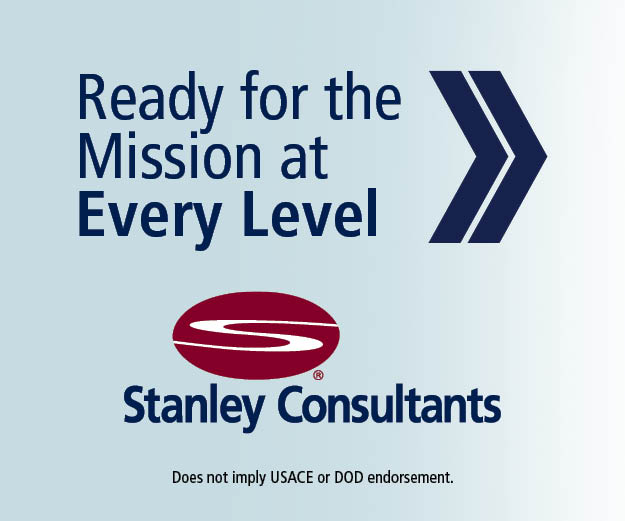
5 minute read
Army Engineers Finalizing the U.S. Military’s $10.7 Billion Relocation Effort in South Korea
BY SEUKHWAN SON AND RACHEL NAPOLITAN, FAR EAST DISTRICT
Just a 45-minute drive from Seoul is now the heart of the U.S.-ROK Alliance and the home of more than 45,000 Soldiers, civilians, and family members stationed overseas in Korea. Part of a $10.7 billion transformation and relocation, the U.S. Army Corps of Engineers – Far East District (FED), in partnership with the Republic of Korea, took on the massive job that turned rice paddies and open fields into the largest overseas U.S. military installation – U.S. Army Garrison Humphreys.
“Operational and strategic infrastructure requirements, combined with aggressive and innovative land reclamation actions, have dramatically improved the ROK-U.S. ability to ‘Fight Tonight,’” said. Col. Heather Levy, district commander. “The move helped make Korea a station of choice with new barracks, housing, schools, and other quality-of-life facilities.”
The largest peacetime relocation in the Department of Defense history is a “significant investment in the long-term presence of U.S. Forces in Korea,” noted Gen. Vincent Brooks on June 29, 2018, during the ribbon cutting ceremony of United Nations Command and United States Forces Korea’s new headquarters facilities.
To date, approximately 97% of the Yongsan Relocation Plan (YRP) and 98% of the Land Partnership Plan (LPP) are complete.
“As the programs near completion, it truly marks a new era of unwavering USROK alliance,” Levy said.

To turn rice paddies into an installation the size of Washington, D.C., contractors used more than 18 million cubic meters of engineered fill to create the foundation of the garrison. They also installed new underground infrastructures, roads, waterlines, gas, sewer systems, power and treatment plants, and substations that each comprised of more than 40 miles. Over 1,000 miles of cable and 2.7 million cubic meters of concrete were used to build facilities across the installation.
“The relocation of U.S. forces from Yongsan Garrison to Camp Humphreys is the fulfillment of a decades-long promise by the Korean government,” said Jamie Hagio, FED’s Construction Division chief. “The program provided new and modern facilities. It also improves readiness and survivability for U.S. forces while reducing inconveniences to the Korean community.”

The job to relocate the U.S. military from Yongsan Garrison to south of Seoul began in 1987 when officials created a master plan for what is now Camp Humphreys.
Agreements signed in 2004 formerly designated the new footprint for the American military in Korea.
To make the vision a reality, contractors demolished more than 300 facilities so 641 new ones could take their place, transforming a garrison that was once 1,210 acres into a 3,528-acre installation the size of a medium American town.
“FED focused on quality, meeting U.S. requirements, and ensuring professional standards while working with numerous partners to deliver this massive program,” Levy said.

Primarily funded by the Korean government at 55% of the cost, the U.S.-funded military construction projects totaled 45% for YRP infrastructure. To supplement the expense, U.S. Forces Korea funded these projects with funds allocated from the Republic of Korea.
The ROK Ministry of National Defense –Defense Installations Agency (MND-DIA), the counterpart to FED, served as the contract executer for many of the projects. USACE then provided oversight of all the projects to ensure they met not only all U.S. life, health and safety requirements, but also provided all the units using the new facilities everything they would need to seamlessly relocate.
Hagio served FED as the Humphreys area engineer overseeing high peaks of the construction and later returned to the district as the Construction Division chief.

“The Korean government, along with Korean construction industry, took on the task of the $10.7 billion relocation effort,” he said. “It was a tremendous effort, and I am very proud of everyone’s effort to make YRP a success.”
Due to the time constraints, vertical construction occurred in conjunction with or prior to the completion of the infrastructures such as roads and utility lines.
“Through all the hardships and difficulties, cooperation and trust were established,” Hagio said. “Years from now, our countries will look back at YRP and remember working together to make it a reality.”
To navigate a joint construction effort, representatives from both USACE and MND learned lessons on funding management, program management, and quality assurance and quality control.
“I believe that true friendships were made during the YRP process,” Hagio said. “I am most thankful for this. It is my hope that the U.S. and ROK can continue to work together to overcome the challenges that our countries will face in the future.”










